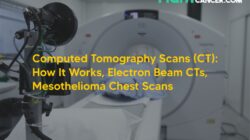X-ray is a form of electro-magnetic radiation with a wavelength of 10 to 0.01 nanometers; much like gamma rays but shorter than UV rays.
X-rays contain high energy radiation exposure because they have an extremely short wavelength and high frequencies.
Just like Computed Tomography (CT) scans, X-Rays use ionizing radiation to create radio waves to create visuals of different organs of the body including the lungs.
Once the x ray machine aims at the part of the body that is to be visualized such as the lungs, it will emit a small burst of radiation that will pass through the skin and record image of internal organs of the body on a photographic film or a special image recording plate.
Different organs of the body will absorb the x ray radiation in different ways. For instance dense bones will absorb almost all of the radiation while soft tissues such as muscles, fats & other organs will allow more of the x-rays to pass through them.
Due to this, bones appear white on x-rays while soft tissues are presented in shades of grey and black. X-Rays are also very similar to visible light rays where electromagnetic energy is carried by particles known as photons.
The difference between x-rays and visible light rays is the energy levels of individual photons, also known as the ‘Wavelength.’
How Are Chest X-Rays Performed?
A chest x-ray diagram is shown on the left. Typically, the patient stands up against the image recording plate and two photos of the chest are taken. One is from the back and the other is from the side of the body.
The radiologist will instruct the patient to put his hands on his hips and chest pressed against the image plate. For the second photo, the patient’s side is against the image plate with arms elevated. Patients with difficulty standing can be positioned lying down on the table.
While the x-ray is taking place, the patient will be asked to hold his breath and lay still for a few seconds to reduce possibility of blurred images.
After the x-ray is over, the patient will not be let go until the radiologist confirms the picture is of good quality and can be reviewed by doctors.
This entire process can take up to 15 minutes. Additional x-rays may also be required after a few weeks or months; this is known as Serial x-rays.
Sources of X Ray
X Ray Photons are produced when the electron beam flashes on the patient. The electrons in the beam are contained in a heated cathode filament and the point where the beam & the target meet is known as the focal spot.
The kinetic energy that is contained in the electron beam is turned into heat and about 1% of it is converted to X-Ray photons. Any excess heat is dissipitated via a heat sink.
The X-Ray beams that are created are projected on a film or a substance of ‘matter.’ Some of the x-ray beams will pass through the patient, while the rest will be reflected.
The resulting image created by the dose of radiation exposure is then captured on a projected film, semiconductor detectors or X-ray image intensifiers.
An X-ray Image Intensifier is a specialized piece of equipment that uses x-ray beams to create ‘live’ image feeds that are displayed on a computer screen.
The Image intensifier is so sophisticated such that the x-ray beams could be of low radiation exposure resulting in a lower radiation exposure to the patient.
Benefits of X-Rays
- i) X-Rays have no side effects
- ii) X-Ray imaging is quick and cost effective
- iii) X-Ray imaging is good for emergency diagnosis & treatment
- iv) Radiation exposure does not remain in the patient’s body after x-ray is performed
- v) X-Ray equipment is available at almost any clinical office, hospital or treatment center
Risks of X-Rays
- i) There is a small chance that cancer can be caused by radiation exposure coming from the x-ray machine
- ii) Pregnant women should not take x-rays as radiation exposure could negatively affect the baby.
dr. Bulawan









